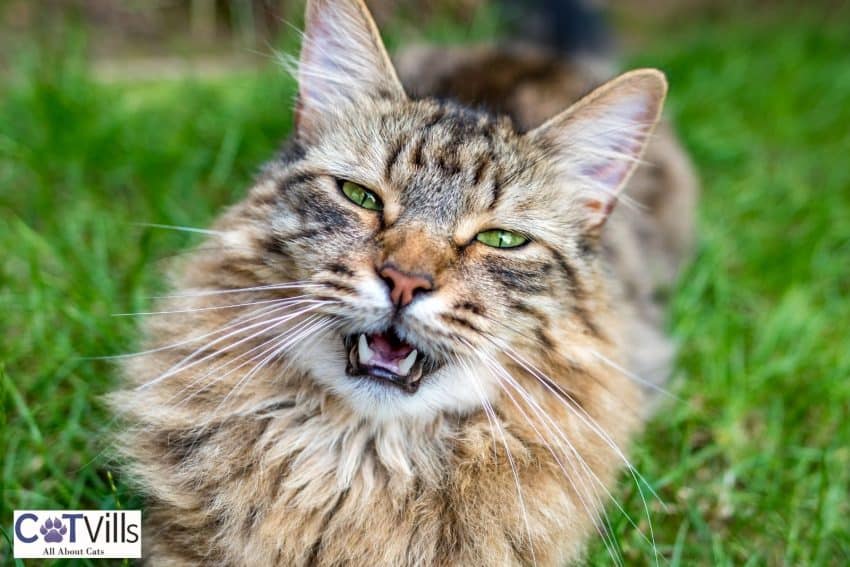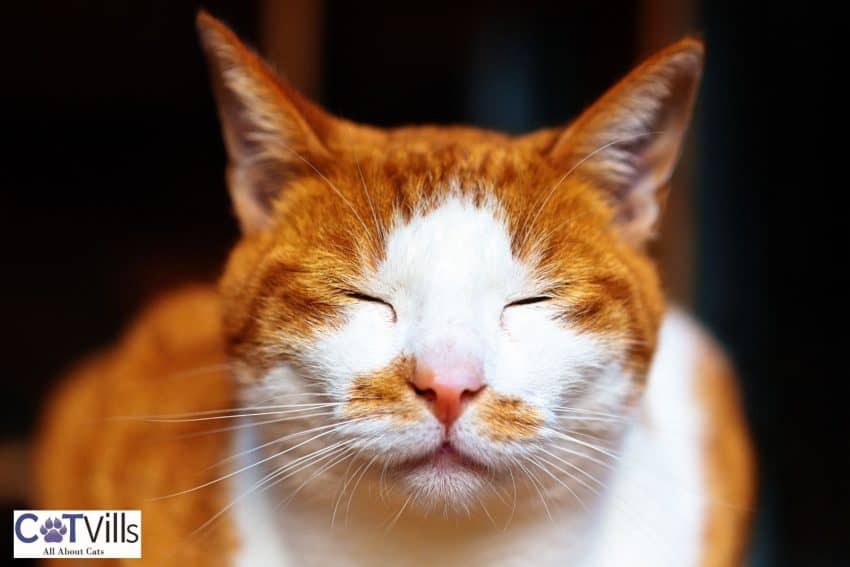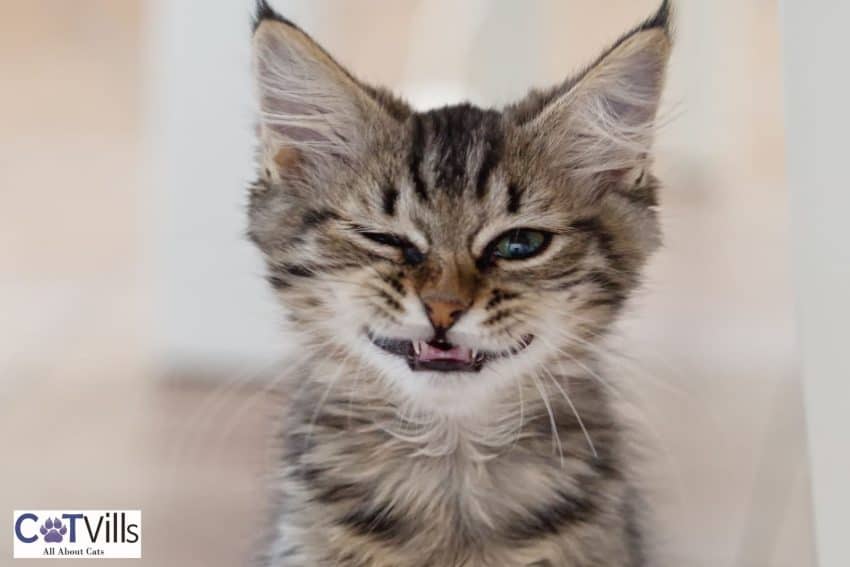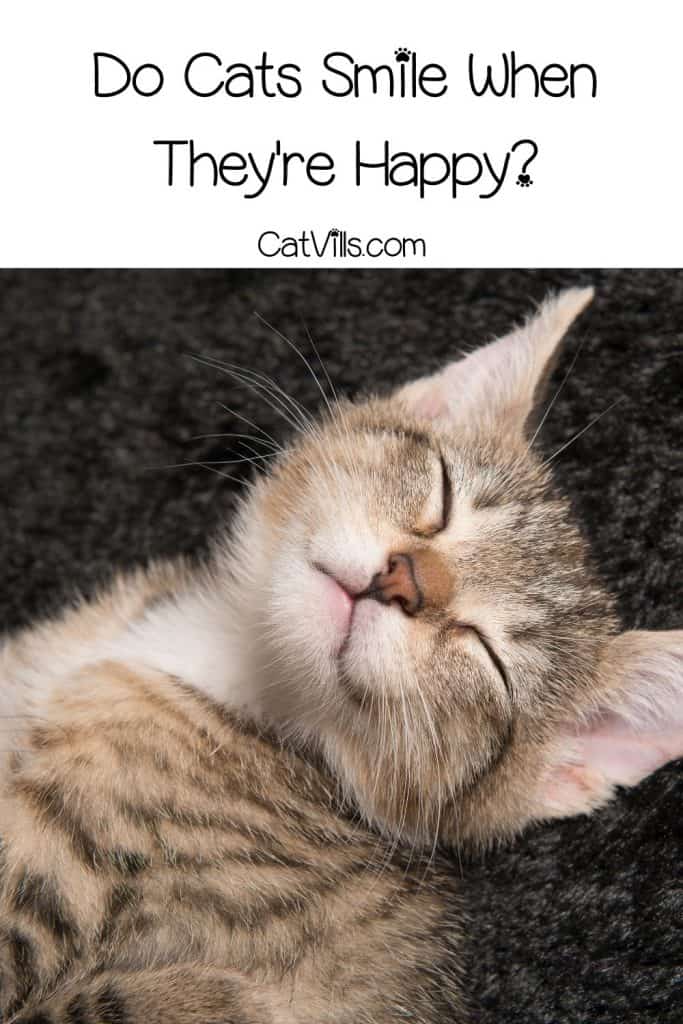Last Updated: 5 months ago
Few animals can look as smug or self-satisfied as a cat, and with the upturned corners of their mouth, you may wonder, “do cats smile?”
While felines certainly do have a vast range of expressions, smiling is a form of human communication.
But, that doesn’t mean they don’t have their own ways of smiling or expressions that look like smiling, and understanding these can deepen our understanding of cats and improve feline welfare.
Keep reading to learn do cats smile!
Can Cats Smile?

The expression that looks most like a cat smile is something called the Flehmen response. A cat will lift its top lips to gather up the scent of pheromones from another cat for the Jacobson’s organ in its mouth.
Other times, we think a cat can smile because of the anatomy of its mouth, with its lips naturally curving upward.
In reality, baring teeth is a vital part of animal behavior. It can mean showing dominance or giving a warning when threatened.
This doesn’t mean cats can’t smile; they just do it differently. Cats smile with their eyes; by staring at us with soft, lazy eyes and giving us a “slow blink”, they are showing us a smile.
Pet owners can give a slow blink back. These slow-blink interactions can be an easy way to exchange affection between yourself and your cat.
Why Do Cats Smile?
Sometimes it does look like our cat is giving a genuine smile. It’s vital that pet owners can read animal behavior.
We can be relatively sure that cats are not trying to communicate how they feel when they seem to be smiling. So, why do they ‘smile’ then?
1. Pain

Cat “smiling” can be a response to severe, sudden pain. This can serve as a helpful indicator in gauging the health and welfare of cats.
Suppose you notice this happening when you touch a specific spot or press down in the abdominal area. In that case, it could signify something more serious.
If there is reasonable cause to believe that your cat might be in pain, the facial expression may indicate that you should act on it and visit a vet.
2. About to attack
It is the one case in which the smiling expression may serve to communicate, at the very least, a warning. A cat does not make an elaborate facial expression before attacking prey. This is common animal behavior.
Cats share complex social interactions. When a cat is in conflict with another cat, it might adopt a severe, smiling expression before attacking.
Along with obvious cues in the cat’s body language, such as hissing and bristling, the intent to attack is usually clear. The behavior can also occur in very stressful situations.
3. A specialized sense of smell
Cats have additional recessive soft tissue in the roof of their mouth. Contracting their faces into smile-like expressions allows them to analyze complex odors via a sensory perception called the Flehmen response.
A range of species, both wild and domestic, also exhibit the flehmen response. It appears to be more noticeable in adult cats because they generally have a neutral expression.
Being able to do this is particularly important for interpreting the pheromones that other cats give off. A strong urine smell can also evoke the expression.
How Do Cats Smile?

Cats have some behaviors that are close to a smile in cat language. The closest is slow blinking behavior.
The cat may stare at you with a soft face and blink slowly, almost as though they are sleepy.
This seems to be a form of emotional communication between cats and humans. If you blink back, they may blink again.
The slow blinking seems to be associated with positive emotions and bonding, much like smiling.
Do Cats Understand Smiles?

Cat’s do not understand smiles the way people do. It’s hard to guess what a cat might think when they see a human smiling, but there is no reason to believe that they interpret it as happy.
Cat lovers know that their feline friends are high on the list when it comes to animal cognition, but certain human behaviors just don’t register.
We are very loud creatures to cats, which is why they need to tune us out.
On the other hand, a sensitive cat can be made very uncomfortable by smiling and eye contact.
If a stranger arrives at the door with a gigantic smile and makes hard eye contact, a timid cat can read this as threatening behavior and try to scare him.
This can be confusing to a visitor or child who just wants to cuddle the kitty.
Should I smile at my cat?
You can smile at your cat if you like. A warm smile with relaxed, closed lips and a slow blink is best. There are no conclusive studies that suggest that cats interpret human smiles in any way.
Cat’s are pretty smart, and they know that we aren’t cats. They don’t seem to read too much into our expressions or body language. On the whole, they instead look for cues in the tone of our voices.
Signs That Your Cat is Happy
How can you tell if a cat is happy?
A happy cat has a healthy appetite, is comfortable in its environment, and is generally playful. It all varies among individual cats, but high-pitched vocalizations and purring are also good indicators.
A cat’s general attitude also says a lot about its state of mind. Confidence indicates that a cat is happy.
- A happy cat is a playful cat. That might involve faux-hunting, chasing, pawing, and scratching.
- Subtle eye contact. Happy cats communicate that they are content with your presence by blinking slowly. Remember to blink back! It’s only polite.
- If a cat is relaxed, it is likely that it is also content. An unhappy cat won’t lie around with a relaxed posture. Calmer situations also make for a happier cat.
- A cat’s ears and eyes can tell you a bit about its mood. A happy cat will have their ears upright, tilted ever so slightly back, facing forward, but not perked. Its pupils may dilate if it is very happy.
- Where the cat sleeps says a lot about how they feel. Sleeping close to you or other pets indicates that your cat has positive relationships with her housemates that make her happy. Sleeping close to you is one of the signs that a cat loves you
- Happy cats eat well. Your cat’s appetite can be a good indicator of their general mood. If they are happy, they will have a healthy appetite. Just as is the case with humans, eating too little or too much might signify that they are experiencing emotional challenges.
- A happy cat will maintain an active grooming regimen. Cat’s largely groom themselves, but if they are unhappy, they may do so less often.
- Happy cats are generally pretty vocal. That depends on the breed and the individual cat, but happy cats make sounds. The pitch of the sound can tell you a lot about how your furry friend is doing. A higher pitch indicates that your cat is happy, or at least content. Low-pitched sounds suggest that they are irritated or uncomfortable.
- Confidence is another sign of a happy cat. It’s a little less obvious than some of the other tells, but your cat’s general attitude in terms of their confidence says a lot about their current state of mind.
Conclusion
Cats can contract their faces into an expression that looks like a smile. However, while it can be very cute, it does not express the same thing that a human smile does.
Aside from being a warning, a cat might make the expression an involuntary response to sudden and severe pain.
In most cases, however, they are likely analyzing complex pheromones using the soft tissue in the roof of their mouths. The latter is called the Flehmen response.
References:

